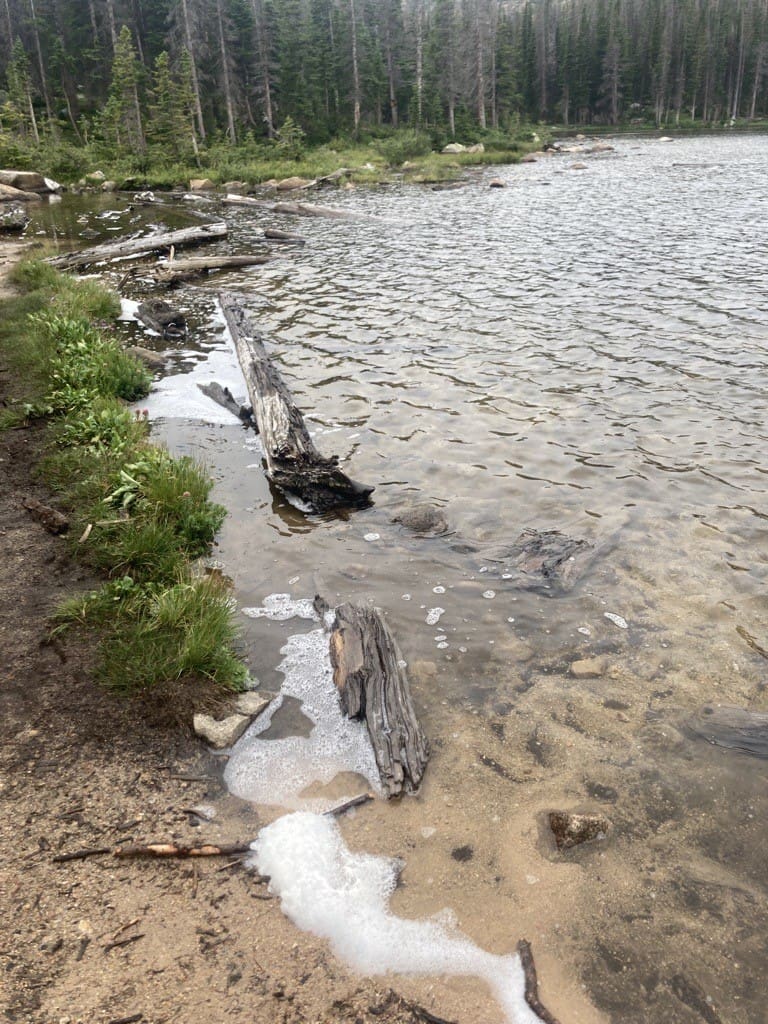
Note: This article is part of our new monthly environmental series in the Mountain Mail.
If you have ever explored the Arkansas River or one of our many local alpine lakes, you’ve probably encountered foam floating on the water’s surface. Maybe you avoided stepping into the foamy buildup at the water’s edge while enjoying a day on the river or scrunched your nose while passing a particularly pungent patch of froth. Perhaps you’re an angler who fishes the foam line. Maybe you didn’t give the foam a second thought, but members of the Greater Arkansas River Nature Association’s hiking club sure did after observing suds on the shore of Water Dog Lakes in mid-August.
So why does foam accumulate at the edges of rivers and lakes? And is it something we should be worried about? In our inaugural article for GARNA’s environmental education column, we will explore natural and toxic froth to answer these foaming questions.
The natural suds you find in alpine lakes and rivers are not what you’d find in your kitchen sink. Rather, foam is the byproduct of a lake or river’s digestion of organic matter. As plant and animal matter decompose, they release dissolved organic compounds (DOCs) into the water. These compounds are surfactants, which disrupt the water’s surface tension so air molecules may mingle with water. Waves, wind and rain mix air molecules with DOCs, creating the natural froth that accumulates on the water’s surface. Foam is consequently created at a greater rate in riffles and rapids than in still water and during turbulent storms as fast winds, choppy waves and rain mix DOCs and air molecules.
Natural foam is indicative of a nutrient-rich body of water and is usually not cause for alarm. It can be identified by its off-white, tan or brown color and fishy or earthy smell. It browns over time as dead and dying aquatic macroinvertebrates and other debris are caught in its froth. Fish find shelter under these accumulated suds (hence trout anglers’ gravitation to the foam line) and snack on its buggy passengers.
Not all foam is naturally occurring, however. Cleaning products, detergents, pesticides, drilling fluids, PFAS in firefighting foams and other industrial discharges contain harmful surfactants. These surfactants act similarly to DOCs, relieving water’s surface tension and allowing surfactants to mix with air molecules. But, unlike natural DOCs, man-made surfactants create potentially toxic synthetic foams that may irritate the skin or cause harm if ingested or introduced to the body through an open wound.
Detergent-based foam also looks and smells different from DOC-based foam. Toxic foam tends to be bright white in color, but it may brown over time like natural foam. It breaks down less easily than natural foam and may even blow from the water’s surface. The most identifiable feature of man-made foam is its soapy or perfume-like smell.
As some foams are caused by both environmental and man-made surfactants, it may be difficult to determine if foam is safe or not. Regardless of their toxicity, foams usually support a host of dead and decaying material as well as potentially harmful bacteria. It is thus a good rule of thumb to avoid touching or ingesting foams and to prevent your dog from doing the same.
If you have reason to believe that river or lake foam is toxic, help us keep our Arkansas River Valley water sources healthy by reporting the suds to the Colorado Department of Public Health and Environment.
Rose Nadelhoffer is the public programs resource assistant for the Great Arkansas River Nature Association.

GARNA works with communities of the upper Arkansas River valley to foster the stewardship of the region’s natural environment and the resilience of our communities.